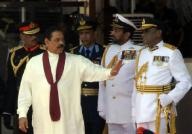 Sri Lankan President Mahinda Rajapaksa won a 25-year war with the Tamil Tigers long viewed as unwinnable, but now faces the challenge of reducing social and economic inequality that fueled that war and other insurgencies.
Sri Lankan President Mahinda Rajapaksa won a 25-year war with the Tamil Tigers long viewed as unwinnable, but now faces the challenge of reducing social and economic inequality that fueled that war and other insurgencies.
The effective end in May of the Tamil Tigers’ rebellion is no guarantee of long-term peace unless the government can also deal with the root causes that linked the Tiger fight with two bloody Marxist uprisings, analysts say.
A boom in the Colombo Stock Exchange linked to government success in the war, falling interest rates and anticipated foreign direct investment are cold comfort to many of Sri Lanka’s 21 million people.
Most depend on agriculture and want postwar progress faster than trickle-down effects from economic liberalisation are likely to deliver.
"Given the military’s success in what many considered an unwinnable war, the government has certainly earned itself real credibility over recent months," said John Drake, an analyst with London-based risk advisers AKE Group.
Rajapaksa has already shown commitment to organising elections in conflict-affected areas, and has ambitious plans that "will require the government to follow its political and economic goals as much as its military ones", Drake said.
Census and Statistics Department data show the poorest 40 percent of Sri Lanka’s people have only 13 percent of total income, while the richest fifth enjoy 54 percent.
Considering how the Liberation Tigers of Tamil Eelam’s (LTTE) separatist struggle shaped external perceptions of the Indian Ocean island after it erupted in civil war in 1983, it is easy to forget two other bloody uprisings since 1971, where Marxist leaders drew popular support from economic inequality.
Minority groups like the Tamils have also charged post-independence governments and the ethnic Sinhalese majority with political and social discrimination.
Rajapaksa’s answer for that is for Sri Lanka to turn the energy it gave to the war toward development and social reform.
AMBITIOUS PLANS
But much depends on the president’s execution of the plans and his ability to convince a historically fickle electorate he is serious about them, even if they take time.
In the past the president used the war as a national rallying point, which allowed him to persuade potential political opponents to back down on demands until it was finished.
That approach helped Rajapaksa convince labour unions backed by the Marxist Janatha Vimukthi Peramuna (JVP) party to halt occasionally violent strikes and protests.
With the war over, patience could turn short.
"There should be change in the economic framework and (there is) a need to come to an egalitarian economy," said Vasudeva Nanayakkara, a Marxist who serves as a presidential adviser.
If that doesn’t happen, "there will be a clash between those forces and the government," he said, referring to those elements of society who had rebelled before.
The JVP, mainly backed by working-class Sinhalese from the south, fought the government in 1971 and 1998-89. The military put down both insurrections, killing an estimated 100,000 people — about as many as were killed throughout the 25-year LTTE war.
EASTERN RUMBLINGS
There are already fresh rumblings of insurgency from eastern Sri Lanka, the most ethnically mixed area of the nation where Sinhalese, minority Muslims and Tamils are all strongly represented. It was taken back from the Tamil Tigers in 2007.
Eastern armed groups emerged due to low economic prospects including land and market access, and to protect themselves from the Tigers, rivals, and other paramilitary groups.
This week the military offered amnesty to members of armed groups, including Muslim youth who formed militias, if they surrender their weapons before July 2. Those who do not will have the guns taken by force — no idle threat.
That may solve an immediate problem but longer-term risks will remain. Though poverty is in decline, the government acknowledges it will take time for Rajapaksa’s reforms to substantially transform the economy.
"I don’t see the … reforms which could change the country taking place overnight," said Central Bank Governor Ajith Nivard Cabraal, one of Rajapaksa’s economic advisers during his election campaign. But, he said, "revolution is taking place."
The first steps, already underway, are major infrastructure projects like a Chinese-financed port in Rajapaksa’s Hambantota district and a Chinese-funded coal power plant.
India has meanwhile pledged to help rebuild former LTTE areas after the war, and China also has said it will take part.
Rajapaksa is also pushing change in agriculture, bringing in the father of India’s Green Revolution, M.S. Swaminathan, to boost local production and cut dependence on imports.
It remains to be seen if all of those efforts will show results fast enough so Rajapaksa can keep his diverse constituencies happy, and away from violent politics that have been the rule for decades in the country.
(For updates you can share with your friends, follow TNN on Facebook and Twitter )
